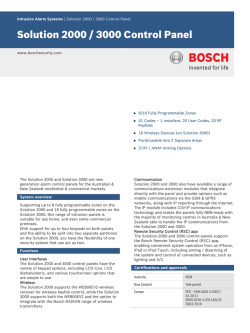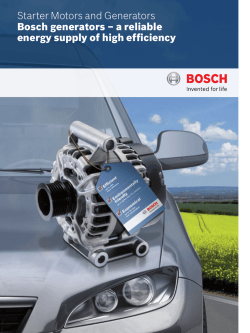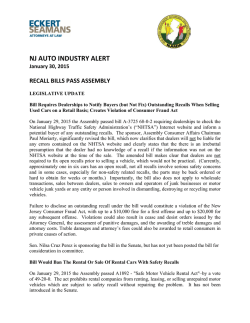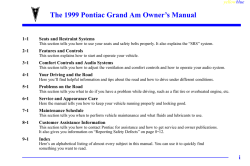
CAN YOU HEAR THEM KNOCKING?
Pg_EDIT_Servop:Pg_EDIT_ 12/16/14 11:38 AM Page 1 CAN YOU HEAR THEM KNOCKING? NEW SERVICE OPPORTUNITIES BY BOB CHABOT I f you’re an independent shop owner or technician looking for new and profitable service opportunities you could implement in 2015, where would you begin? That question was on my mind while attending the recent Automotive Aftermarket Industry Week in Las Vegas. In particular, I spent a day at the Automotive Aftermarket Products Expo (AAPEX) trying to walk in your shoes. I prepared a list of 40 exhibitors I wanted to visit. I also allowed time to visit a few other exhibitors along the way, should a display catch my eye. To be effective, I used this question: “Hi. For a shop owner looking for new service opportunities, what do you have new at this show that I could consider?” This question helped sort wheat from chaff. In total, I visited 44 booths that day. Most exhibitors had nothing new, so I thanked them and moved on; however, 11 did. From 30 January 2015 Photo courtesy Robert Bosch GmbH Some look at the growing complexity of today’s vehicles and see only obstacles. Others see things differently. With well-placed investments in tools and training, the same complexity can be mastered and turned into opportunity. Pg_EDIT_Servop:Pg_EDIT_ 12/16/14 11:38 AM Page 2 January 2015 31 Pg_EDIT_Servop:Pg_EDIT_ 12/16/14 11:39 AM Page 3 CAN YOU HEAR THEM KNOCKING? NEW SERVICE OPPORTUNITIES those, four were selected for this article. They represent a mix of new service opportunities—some more costly, some requiring no additional investment and some somewhere in between—but each offers a profitable revenue stream worth considering. Catch the GDI Wave Photo courtesy Robert Bosch GmbH At Industry Week, Robert Bosch GmbH invited MOTOR to a private reception, where several key executives shared Bosch’s plans for the future in North America. Among the new service 2020. In addition to our relationships with European OEMs, significant inroads have been made with U.S. domestic and Asian automakers, to the point where Bosch content is in almost every vehicle today.” “Automotive technology is light years ahead of where it was just a decade ago,” said Dr. Odd Joergenrud, Bosch Regional President for North America. “Vehicles are becoming much more efficient, but further improvement is mandatory. Today, automakers must deliver 24 mpg average fuel economy. In MOTOR met privately on the AAPEX Show floor with several Bosch product managers who demonstrated the complete Bosch GDI Parts, Bytes, Services concept and provided an overview of Bosch’s new interactive GDI micro-website. Before the new GDI microsite is launched, MOTOR will be meeting again with Bosch and will provide further details. A GDI engine is shown here. and repair opportunities described for independent shops, Bosch’s plans for gasoline direct injection (GDI) impressed me as the most immediate new service opportunity. “Bosch views the North American vehicle service market as being underdeveloped,” stated Dr. Uwe Thomas, Global Chairman of the Bosch Automotive Aftermarket Division. “We see that as an opportunity for us to grow the Bosch Aftermarket service shop network by 50% in North America by 32 January 2015 order to reach the federal 55-mpg target by 2025, manufacturers must more than double fuel economy. “To meet future mileage requirements,” noted Dr. Joergenrud, “automakers have been trending toward lighter weight engines equipped with GDI and turbocharging technologies. Of Ward’s Top Ten Engines for 2014, five have GDI, four have diesel and one is electric. Bosch technologies powered eight of these engines.” According to Dr. Joergenrud, GDI is poised for rapid growth. He stated that in 2015, nearly 50% of vehicles sold in North America will include GDI systems, and by 2018, that number will grow to 18 million North American vehicles. If you aren’t servicing GDI systems now, you’d better be able to soon. “Servicing of these sophisticated and precise systems requires the use of high-quality parts; bytes, which includes diagnostic scan tools, specialty tools and equipment; and services, such as testing, training and technical support,” Dr. Joergenrud cautioned. “Shops and technicians that don’t prepare properly for GDI service, or who take shortcuts in adding or providing GDI service—with substandard parts, tools, procedures and training—negatively affect emissions efficiency, performance and safety.” George Kostopoulos, Bosch Vice President, OES Sales, said, “Speed in the service bay matters; it’s where technicians spend the majority of their time. Our goal is to provide shops and technicians with the ability to service the 37 current and new GDI-equipped vehicles entering the North American market. Quality parts, advanced scan and specialty tools and complete knowhow are essential. A shortfall in any area can make a GDI service or repair much more time-consuming, if not impossible, to effect. To that end, Bosch is uniquely positioned as a convenient, one-stop source for shops and technicians to acquire everything they need to competently, efficiently and safely provide GDI service.” Capture Revenue Before It Leaves Your Shop “There’s been a material change in accessory belt drive systems that shops, technicians and even most automakers haven’t adjusted too yet,” shared Robert Basset, Gates Corp. Manager of Training. “Belt material has recently changed from neoprene to longer lasting ethylene propylene dyne monomer (EPDM) rubber. Today’s EPDM belts can run well over 100,000 miles before being totally worn out. In other cases, they can wear out sooner, yet appear brand new because of their EPDM construction. Pg_EDIT_Servop:Pg_EDIT_ 12/16/14 11:40 AM Page 4 CAN YOU HEAR THEM KNOCKING? NEW SERVICE OPPORTUNITIES ple spray bottle test can help direct the technician to the cause of a belt noise: If the noise increases when the belt is sprayed, it’s tension-related; if it goes away and then comes back, it’s a system alignment problem. “Modern accessory belt drive systems are engineered as a system and should have recognized this,” Basset went on. “But the few that have say it will take time to amend their service information procedures. That’s why Gates is offering training to independent shop technicians and working with partners like M OTOR to help inform technicians and shops of this profitable ser- Chart courtesy Gates Corp. “While loss of tension in the accessory belt drive system (ABDS) remains the root issue with most customer complaints, most shops routinely replace serpentine belts without identifying the actual underlying root cause,” Basset added. “The belt may not be the problem; even worse, other com- Gates has developed the DriveAlign Tensioner Multiplier, a calculator shops can use to determine how much revenue they’re losing annually by not suggesting a tensioner at the same time they sell a replacement serpentine belt. Call your Gates representative for a demonstration. ponents within the system may soon fail, resulting in a comeback. For example, belt slippage creates problems such as belt noise, heat for the bearings, loss of efficiency for the accessories, false codes, comebacks and loss of profits for the shop. Just 5% belt rib wear can create loss of tension, noise and heat in the system. And when loss of tension occurs, excessive heat is generated, which migrates through the belt into the pulley, shafts of the accessories and then into the bearings, creating premature grease boil-out or bearing failure.” Basset considers belt noise a symptom of an ABDS systems issue. More often, he says, the loss of tension is more likely caused by a failing tensioner, which generally doesn’t get replaced, or ABDS system misalignment. A sim- 34 January 2015 be treated as such when serviced,” Basset emphasized. “If something in the ABDS is amiss, replacement of the belt may not be enough; other components may also need replacement. That’s why we recommend ABDS inspections begin at 30,000 miles. “If either the belt or tensioner is failing, less energy from the crank is transferred to power accessories, until both the belt and tensioner are replaced,” Basset said. “Not explaining this to customers and suggesting that both the belt and tensioner may need replacement is a decision by the shop that reduces revenue from vehicles already in the shop’s service bay. In addition, failing to take a systems approach sets a shop up for a comeback and an unhappy customer. “Some, but not all, automakers vice opportunity. The end result will be a more satisfied customer and increased shop revenue, without any additional investment.” Making Old Better Than New Walking the show floor, I ran into Ron Bilyeu, owner of Pro Dyno Tech in Thorntown, IN. A performance tuner for more than 30 years, he also provides training and other resources to aspiring tuners. “Consumers are keeping their vehicles longer,” he told me, “but even with new vehicles, owners are often not aware their vehicle can be tuned in areas such as engine performance, suspension and ride, body controls and others that better suit their driving habits or needs. Examples include improving torque and horsepower, fuel Pg_EDIT_Servop:Pg_EDIT_ 12/16/14 11:41 AM high-airflow headers and other components. “But tuning isn’t as easy as going to an auto parts store, buying tricked-out camshafts, cylinder heads, turbocharger, etc., then bolting them onto the vehicle. To make the most of the upgraded parts, you must have a detailed, drawn up expectations, which keeps both them and the shop happy. Too often, I’ve seen people spend thousands on components, equipment and shop time to tune a vehicle, then find out the upgrades installed will not work, or will require more components and tuning time,” Bilyeu said. “Required tools and equipment in- Illustration courtesy Pro Dyno Tech economy, shifting, ride and other enhancements.” Bilyeu said that performance tuning “is a viable opportunity for the savvy shop to attract new business from customers happy to see you and, when done right, it provides a lucrative revenue stream. For example, it takes me Page 5 According to Ron Bilyeu of Pro Dyno Tech, the ELM 327 Dongle and OBD II Tuner Box (displayed above) are two essential tools that allow a performance tuner to determine whether the desired performance upgrade is doable and, if so, to modify existing or install new vehicle software. 30 minutes to provide a $400 performance dynotune for a customer.” Just sharing that intrigued me enough to sit in on his class at the AVI Training Conference, co-located at AAPEX. “Most vehicles leave the factory set up for the average driver’s expectations and conditions (however that is calculated),” Bilyeu began. “Performance upgrades leverage software and hardware—cold air intakes, throttle bodies, intake manifolds, camshafts, valvetrains, turbochargers, plan,” Bilyeu emphasized. “Tuners need to know if what they want to do can be accomplished by the hardware and software installed. Planning out your build and making sure the upgrades you want will perform on your vehicle, before you purchase any upgrade performance components, will avoid nightmares. “Savvy automotive performance tuning shops will explain up front to customers, before starting any performance upgrade, why having all the correct hardware matters. This helps meet customer clude a dynamometer, blank programmable read-only memory (PROM) integrated chips, underdash interface device, tuner box and good quality read and write software. Personally, I use the ELM 327 Bluetooth OBD II Wireless Transceiver Dongle, which facilitates the communication of data, settings and software,” Bilyeu continued. “I also use a Computer Automotive Tuning Systems OBD II tuner, which provides me with access to genuine OE software data packets and files, such as spark, power January 2015 35 Pg_EDIT_Servop:Pg_EDIT_ 12/16/14 11:41 AM Page 6 CAN YOU HEAR THEM KNOCKING? NEW SERVICE OPPORTUNITIES enhancement, torque, fuel and diagnostics tables—which I use to test and rewrite vehicle software. Together, these two tools are key to 1. helping me determine whether the desired performance upgrade is doable, and 2. allowing me to modify existing or install new vehicle software. And don’t underestimate or neglect the value of quality training; it helps technicians learn the nuances of performance tuning. It also separates professionals from hacks. And besides minimizing comebacks, training can save you eating the costs of hardware components and wasting your valuable time.” •The software-based scan tool is internet-based, so all the latest vehicle data and software updates are downloaded automatically. •Teacher subscriptions include access to Identifix, which will provide access to genuine service information in a standardized format, making navigation for service information more uniform. •The new tool also includes built-in J-2534 pass-thru capability for reflashing and reprogramming. Other useful functions of the TechPRO include the ability to conduct and functionality. The new service opportunity the TechPRO presents is clear: Its speed, ease of use and low cost of ownership will allow shops and technicians to expand service beyond one or two specialized vehicle lines to any or all domestic and Asian models. The new service opportunities outlined here are available now to independent shops, as are others. I’m reminded of a scene in the film Patch Adams, with the late Robin Williams. One of the characters engages Adams in a conversation that’s analogous to recognizing new service opportunities. Many independent shops focus on servicing and repairing one or two primary vehicle lines. MAHLE Service Solutions’ new TechPRO diagnostic scan tool—a versatile, software-based, laptop- or tablet-enabled diagnostic scan tool—is a worthy new entry to the category that allows such shops to affordably service any domestic or Asian nameplate, in addition to other benefits. “At its core, the TechPRO diagnostic scan tool was produced to help professional technicians quickly analyze, diagnose and repair today’s sophisticated computer-controlled vehicles,” said Max Dull, General Manager for MAHLE Service Solutions. “Designed to help technicians work smarter, not harder, TechPRO is all about making technicians more efficient. For example, our new tool features the ability to decode a vehicle identification number (VIN) in one second with one click. Plus, the speed of diagnosis is measured in seconds, vs. minutes for competitors’ tools.” There are a number of key features of this innovative diagnostic scan tool: •It was engineered so the vehicle communication interface (VCI) and software can be used with a technician’s current desktop computer, laptop or tablet, making it unnecessary to buy, lease or learn the nuances of extra hardware. •The tool will be affordable, as it won’t require a large initial investment in scan tool hardware; rather, the TechPRO will be sold via annual subscription. MAHLE will begin selling the TechPRO this year and will release the annual subscription fee shortly. 36 January 2015 Photo courtesy MAHLE Service Solutions Expand Your Car Count The new MAHLE TechPRO scan tool’s speed, ease of use and low cost of entry ownership advantages affords independent shops and technicians the opportunity to expand service from one or two primary vehicle brands to any or all domestic or Asian models. and display cylinder balance tests, compression testing, key relearn and misfire graphing. “The TechPRO has evolved from years and years of R&D and technology deployment that providing advanced diagnostic scan tool software for vehicle manufacturers,” explained Dull. “Now that same powerful technology is available for use in the independent aftermarket.” Having seen the TechPRO demonstrated on several vehicles at AAPEX, I was impressed by its speed and versatility, as well as its depth of information “How many fingers do you see,” he asks, holding up four fingers. After Adams replies, the character offers this advice: “Some see four, others eight, but the point is to see what no one else sees. See what everyone chooses not to see, whether out of fear, conformity or laziness.” That’s where service opportunities reside. Seeing them is your challenge. This article can be found online at www.motormagazine.com.
© Copyright 2026








